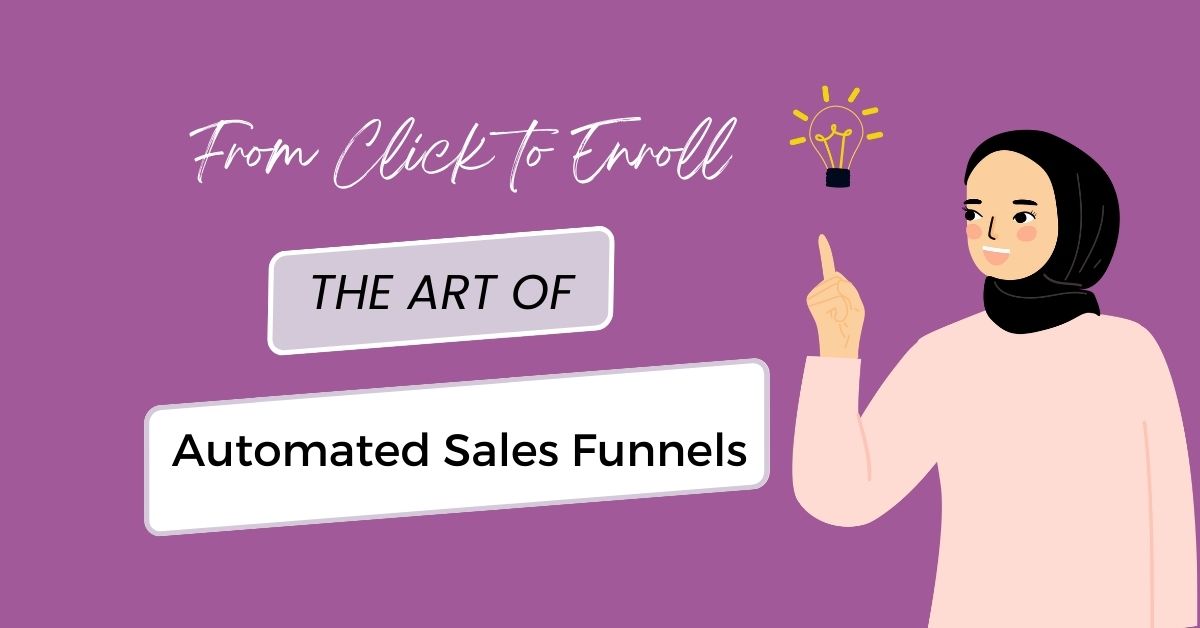
Hey there, fellow online course creators! If you’ve ever wondered about supercharging your business and creating a steady income stream, then you’re in for a treat. In this article, I am going to talk about your secret weapon: Automated Sales Funnels! Don’t be intimidated by the jargon – I am here to break it all down in simple terms.
In this guide, let’s explore what automated sales funnels are, why they’re crucial for your online course business, and how to create one in a step-by-step process. I’ll also dive into essential topics like fine-tuning your funnel, adopting the best practices, and boosting your funnel’s performance.
Getting To Know The Basics
Alright, let’s start with the basics. An automated sales funnel is like a magic pathway that takes your potential customers on a journey from the moment they first hear about your course to the point where they eagerly enroll.
The Stages of an Automated Sales Funnel
There are multiple stages a potential customer has to go through before they actually convert to your customer. Think of it like a well-orchestrated symphony with the following critical stages:
a) Awareness:
This is when potential students first discover your awesome online course. It could be through social media, email, or search engines.
b) Interest:
Now that they know you exist, it’s time to grab their attention. Share some exciting stuff like blog posts, webinars, or freebies that show off your expertise.
c) Consideration:
Your potential students are contemplating whether your course is their jam. Here’s where you show off case studies, testimonials, and detailed info about your course.
d) Intent:
They’re almost there – ready to buy, but they need a little nudge. Offer them discounts, limited-time deals, or some sweet bonuses to seal the deal.
e) Purchase:
Boom! You did it! Your potential customer has turned into a paying student, and they’re all set for your course.
f) Post-Purchase:
It doesn’t end with a sale. Keep providing value, support, and even opportunities for them to get even more out of your course.
The Role of Automation
Now, here’s where the “automated” part comes in. Most of these stages can run on autopilot, which makes your life easier. Automating your sales funnel frees you up to focus on other important aspects of your business.
Why You Need an Automated Sales Funnel
Let’s dive into why they’re essential for your online course business, including fine-tuning your sales funnel, adopting the best practices, and boosting your funnel’s outcome.
i) Consistency and Predictability
With an automated funnel, you can predict your income more accurately. No more relying on sporadic course launches or one-time promotions. Your funnel keeps the cash flowing steadily.
ii) Improved Efficiency
Automation is your best friend here. No more hand-holding potential customers through the buying process. Your funnel does the job 24/7, making your life easier.
iii) Targeted Marketing
Automated funnels allow you to customize your marketing efforts. You can slice and dice your audience and send personalized content, making conversions more likely.
iv) Scalability
As your online course business grows, your automated funnel can handle more students by streamlining the sales process without making you work yourself into the ground. That’s super important for expansion.
Creating An Automated Sales Funnel
Now that you’re sold on your automated funnels, let’s get down to the nitty-gritty of creating one for your online course. We’ll break it down into manageable steps, including fine-tuning your sales funnel, adopting the best practices, and boosting your sales funnel performance.
1. Define Your Target Audience
Before you can build your funnel, you need to understand your ideal students. What keeps them up at night? What are their dreams and desires? Knowing your audience is the key to creating content that speaks to them.
2. Choose the Right Tools
To automate your sales funnel, you’ll need some trusty tools for different stages of the funnel:
- Email marketing platforms like MailChimp, ConvertKit, or ActiveCampaign for marketing automation.
- Landing page builders such as Leadpages or ClickFunnels.
- Payment processors like PayPal or Stripe.
- CRM (Customer Relationship Management) software such as Hubspot, GoHighLevel, or Dubsado.
- Analytics tools like Google Analytics.
3. Create Valuable Content
Your funnel relies on engaging and guiding potential students. That means high-quality blog posts, social media updates, webinars, videos, lead magnets, and email campaigns. Make sure it’s all top-notch and geared to move potential students through the funnel.
4. Build Landing Pages
Landing pages are where the action happens. Make sure they’re designed to convert, with persuasive copy, eye-catching visuals, and crystal-clear calls to action.
5. Implement Email Marketing
This is a powerhouse for nurturing potential students. Create a series of emails that educate, inform, and entice your subscribers to take action.
6. Offer Incentives
Throughout your funnel, give your potential students good reasons to take the next step. This could be a free ebook, a discount code, or access to a webinar. Incentives help move folks from one stage to the next.
7. Test and Optimize
Your funnel is a work in progress. Keep an eye on its progress and make adjustments as needed. A little A/B testing can help you find what works best for your audience.
8. Track Conversions
Use tracking and analytics tools to see how your funnel is performing. Keep an eye on key metrics like conversion rates, email open rates, click-through rates, and your sales numbers.
Embracing Automation
Automation is the heart of your funnel. Let’s see how to automate each stage effectively and make your funnel perform like a rockstar.
i) Automated Email Campaigns
Set up automated email sequences to keep your potential students engaged. For example, when someone signs up for your newsletter, they might get a friendly welcome email, followed by educational content and sweet deals.
ii) Lead Scoring
Use your CRM to score leads based on their engagement. This helps you personalize your interactions, which is key to fine-tuning your sales funnel.
iii) Drip Campaigns
Drip campaigns let you send a series of pre-scheduled emails over time. It keeps potential students engaged without overwhelming them.
iv) Behavior-Based Triggers
Set up triggers in your email marketing platform based on how people behave. For instance, if someone clicks a specific link in an email, you can automatically send them more relevant follow-up content.
v) Personalization
Personalize your communication as much as you can. Use your subscriber’s name, recommend courses they might like, and send personalized offers.
The Magic of Analytics
Data analysis is your secret weapon for success. Without it, you won’t know how well your funnel is performing.
1. Conversion Rate Optimization
Keep an eye on the conversions at each stage. Look for areas where people drop off and work on improving them.
2. Customer Journey Analysis
Get inside your students’ heads and see how they move through your funnel. Look for patterns and exit points.
3. A/B Testing
Experiment with different elements in your funnel, like headlines, images, and calls to action. A/B testing helps you figure out what your audience responds to best.
4. ROI Calculation
Calculate the return on investment for your automated sales funnel process. Consider how much you’ve invested and see how much you’re raking in.
Your Next Steps
Now that you’re armed with the knowledge and the toolkit, it’s action time. If you’re eager for expert guidance and support to kickstart your funnel-building journey, check out my Sales Funnel Building Package. I’ve got a sweet deal to help you automate your online course sales so you can focus on doing what you do best – creating amazing courses and changing lives.
Your success story is out there, waiting for you to write it. An automated sales funnel is your golden ticket to making it happen. So, get cracking, and watch your online course business soar. You’ve got this!
Burned Questions Addressed:
Q1: What’s the deal with these automated sales funnels?
A: Automated sales funnels are like your personal marketing sidekick. They guide potential students from discovery to enrollment without you doing everything manually. It’s a smooth journey that works around the clock, and I’ve got the deets on how to make it happen in our guide.
Q2: Why do I need an Automated Sales Funnel for my online course?
A: Great question! Imagine predictability in your income, less manual work, and personalized marketing – that’s what an automated sales funnel brings to the table. It’s all about consistency, efficiency, and scalability for your online course biz.
Q3: How do I build my own Automated Sales Funnel?
A: I’ve got your back! Building an automated funnel involves understanding your audience, choosing the right tools, creating engaging content, optimizing landing pages, and nailing email marketing. The fun part is, it can all run on autopilot.
Q4: What’s the secret sauce to making an automated funnel rock?
A: Testing and tweaking, my friend! You’ve got to keep an eye on how your funnel’s performing. That means A/B testing, tracking conversion rates, and analyzing the customer journey. Don’t forget to crunch the numbers for your ROI.
Q5: How can I get started with automated sales funnels today?
A: Ready to dive in? Start by understanding your audience, then pick the right tools, create fantastic content, and set up those sweet incentives. And don’t forget to track and analyze your funnel’s performance.

